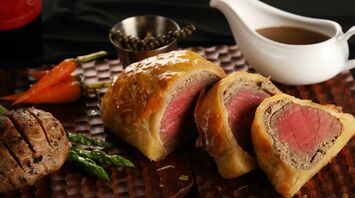The Journey of Beef Wellington: From Historical Mystery to British Culinary Classic

Beef Wellington, a dish synonymous with British fine dining, has captured the imagination of chefs and diners alike with its luxurious combination of tender beef, mushroom duxelles, and flaky pastry. While its rich flavors and elegant presentation are unmistakably associated with British culinary tradition, the history behind this iconic dish remains shrouded in mystery. How did Beef Wellington, a dish with such French-inspired sophistication, become a hallmark of British cuisine? Let’s explore its origins and how it evolved into a beloved staple of the UK’s gastronomic heritage.
The Unclear Origins: Wellington’s Historical Ties
Despite its strong association with Britain, the exact origins of Beef Wellington are difficult to trace. One of the most widely accepted stories links the dish to Arthur Wellesley, the 1st Duke of Wellington, a British military hero best known for his victory over Napoleon at the Battle of Waterloo in 1815. The dish is said to have been named in his honor, though historical records don’t definitively prove this connection.
Some culinary historians suggest that the dish may have been created as a tribute to the Duke’s love of beef, while others argue that the name simply reflects the British penchant for honoring national heroes through food. There is even speculation that Beef Wellington is a rebranding of the French filet de bœuf en croûte—a dish with a strikingly similar recipe involving beef wrapped in pastry. Given the cultural exchange between Britain and France during the 19th century, this theory is plausible, especially since British cuisine often absorbed French influences.
Culinary Craftsmanship: What Makes Beef Wellington Special
What sets Beef Wellington apart is the artistry required to prepare it. The dish features a center-cut fillet of beef, typically one of the most tender and prized cuts, wrapped in layers of finely chopped mushrooms (known as duxelles) and a thin crêpe or prosciutto to keep the pastry crisp. The entire ensemble is then encased in puff pastry and baked until golden and flaky.
The challenge in making Beef Wellington lies in achieving the perfect balance of textures and cooking times. The beef must remain tender and medium-rare, while the pastry should be crisp without becoming soggy. This delicate harmony of flavors and textures is part of what has made Beef Wellington a symbol of elegance in British cuisine, often reserved for special occasions or fine dining establishments.
A Dish for Special Occasions
Beef Wellington has long been associated with celebrations and formal gatherings, a reputation that it still holds today. Its intricate preparation and reliance on high-quality ingredients make it a dish that is often reserved for holidays, banquets, and significant milestones. In Britain, the dish is particularly popular around Christmas and New Year’s Eve, when families gather for festive feasts and elaborate dinners.

Part of its appeal is its visual presentation: a beautifully browned, golden pastry reveals the perfectly cooked beef inside when sliced, creating a dramatic effect on the dining table. This show-stopping quality is one of the reasons why Beef Wellington has endured through generations, maintaining its place as a luxurious dish for memorable meals.
Gordon Ramsay’s Revival of a Classic
In recent years, the popularity of Beef Wellington has seen a resurgence, thanks in part to celebrity chef Gordon Ramsay. Ramsay’s version of the dish, featured frequently on his television shows and in his restaurants, has reintroduced it to modern audiences, many of whom may have considered it an old-fashioned relic of the past.
Ramsay’s take on Beef Wellington stays true to the traditional recipe but incorporates his signature precision and technique, ensuring the dish remains contemporary and appealing. His emphasis on sourcing premium ingredients and perfecting the craft of pastry-making has inspired a new generation of home cooks and chefs to attempt this classic British dish, solidifying its place in both professional kitchens and home cooking.
The Influence of French Cuisine
Though it is considered a British staple today, the French influence on Beef Wellington is undeniable. The dish’s roots in filet de bœuf en croûte suggest that its creation may have been inspired by French culinary traditions, particularly those involving encasing meat in pastry. During the 19th century, French cooking techniques were highly regarded in Britain, and it was common for French chefs to serve in noble households, bringing their expertise in refined, elaborate dishes.
In this context, Beef Wellington could be seen as a product of cultural exchange, blending British preferences for hearty beef dishes with French flair for presentation and technique. Regardless of its exact origin, the dish has evolved into something uniquely British, admired for both its indulgent flavors and its technical complexity.
A British Icon with Global Appeal
Beef Wellington may have its roots in British history, but its appeal extends far beyond the UK’s borders. The dish is now featured on menus around the world, from Michelin-starred restaurants to more casual dining establishments, where chefs experiment with different interpretations of the classic recipe. Some variations include adding foie gras, truffles, or a red wine reduction for extra decadence, while others opt for alternative fillings such as lamb or venison.
The dish’s global presence is a testament to its versatility and universal appeal. Whether served in its traditional form or with a modern twist, Beef Wellington continues to capture the imaginations of chefs and diners, remaining an enduring symbol of culinary sophistication.



















